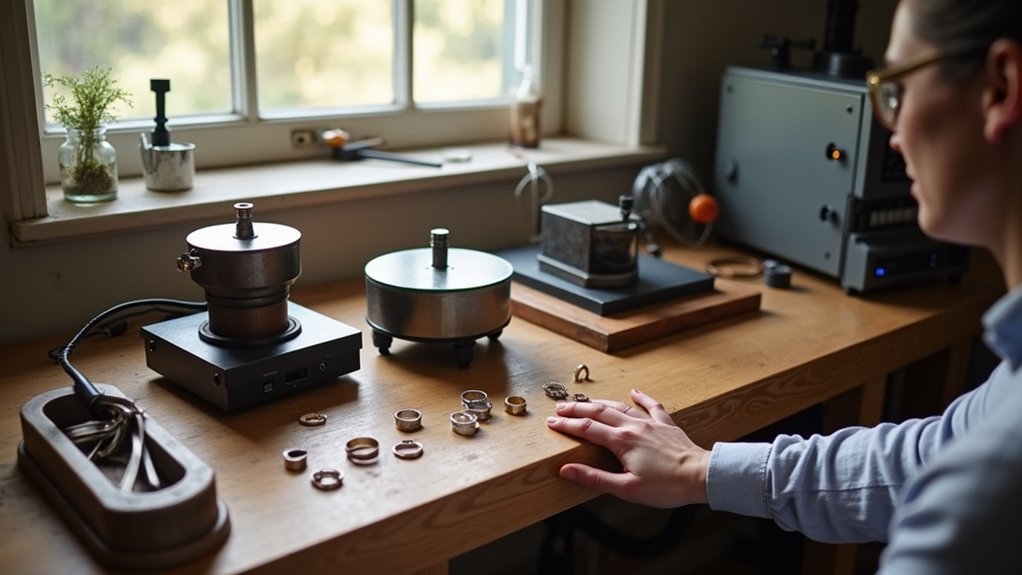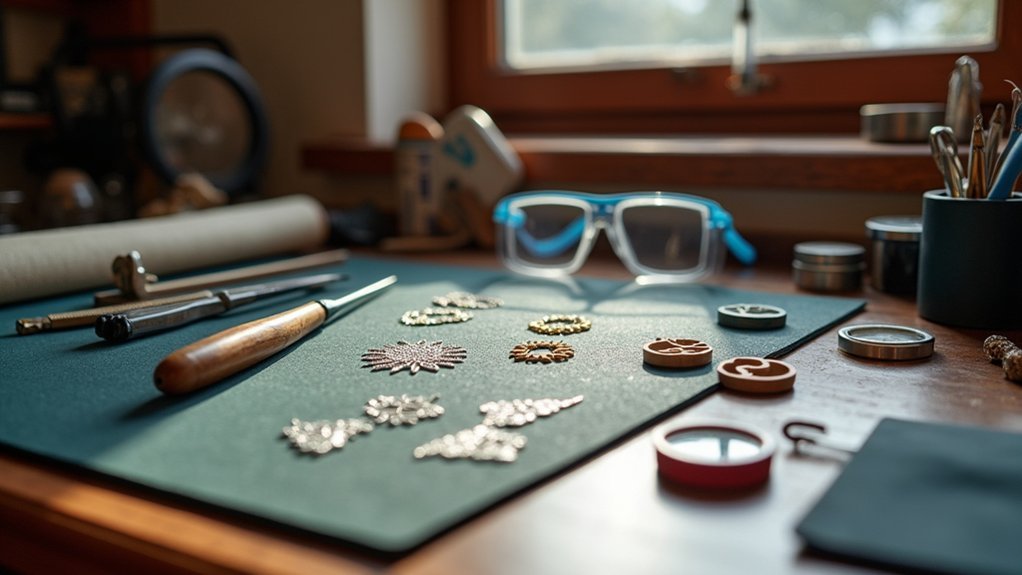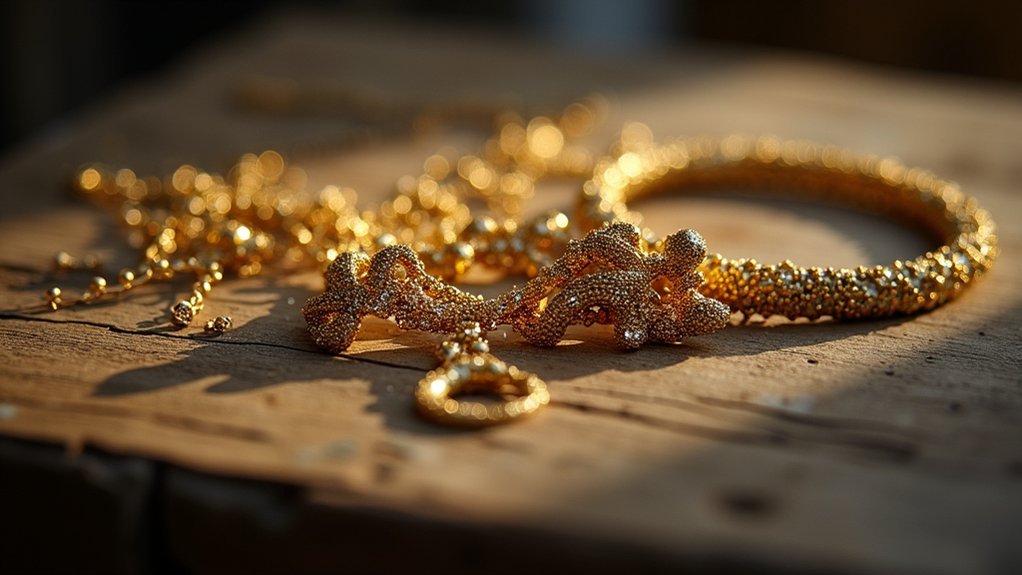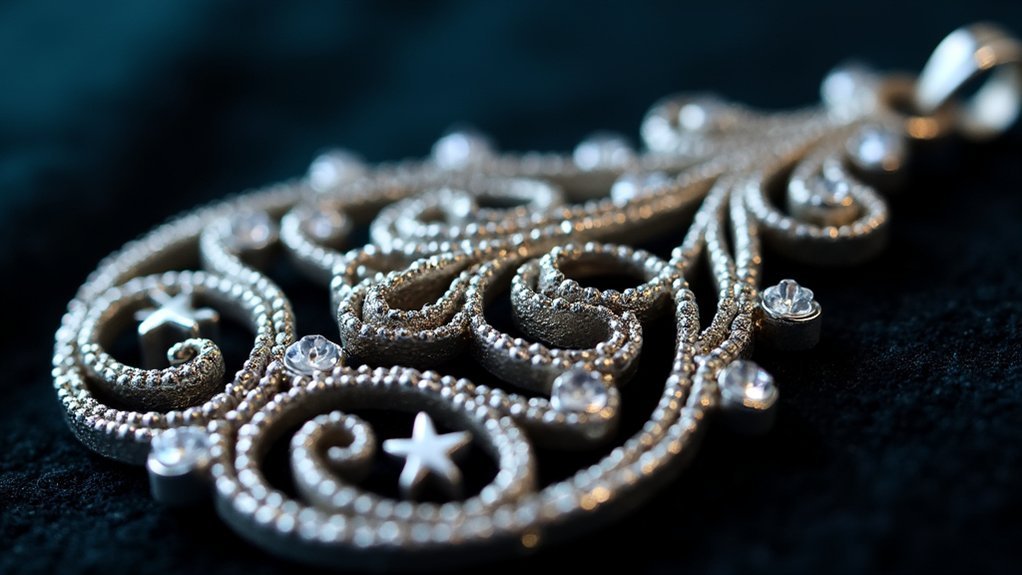You’ve been eyeing those gorgeous cast jewelry pieces on Instagram but think you can’t achieve those results at home? Think again. Setting up a professional-quality casting studio doesn’t require thousands of dollars or industrial space anymore. The right equipment can transform your spare room into a productive jewelry workshop where you can create stunning pieces that rival commercial quality. Let’s explore the three best affordable casting tools that are revolutionizing home jewelry production in 2025.
Cast Master 5-6 KG Propane Furnace Kit for Metal Smelting
For jewelry artists looking to cast small-scale precious metal pieces without breaking the bank, the Cast Master 5-6 KG Propane Furnace Kit stands out as an exceptional entry-level option. At $130, you’re getting remarkable value for melting gold, silver, and other metals up to 5 kg.
The furnace’s advanced insulation and powerful burner guarantee rapid heating while maintaining user-friendly controls. You’ll appreciate its portable design for studio flexibility, though consider upgrading the included tongs and possibly purchasing a smaller crucible for better handling. Apply the rigidizer and refractory cement during setup for maximum longevity and performance.
Best For: Beginner metalworkers and jewelry artists seeking an affordable, portable furnace for small-scale precious metal casting projects without requiring professional-grade equipment.
Pros:
- High efficiency with advanced insulation and powerful burner allows for rapid heating and melting of various metals up to 5 kg
- Extremely budget-friendly at $130, offering excellent value for those entering metal casting
- Portable, compact design enables easy transport and flexible workspace setup
Cons:
- Included tongs are inadequate for safe handling of crucibles and may require immediate replacement
- Large standard crucible can be difficult to maneuver, potentially necessitating purchase of a smaller size
- Initial setup requires careful application of rigidizer and refractory cement for proper functioning and longevity
TFCFL Jewelry Spot Welder and Vacuum Investing Casting Machine
When versatility and precision matter in your jewelry-making process, the TFCFL Jewelry Spot Welder and Vacuum Investing Casting Machine stands out as an excellent option for home studios. This 2L combination unit packs professional features into a stable 33kg frame.
You’ll appreciate the thick aviation plastic vacuum hood that minimizes bubbles and burrs in your castings. The convenient oil level gauge helps maintain peak performance, while the 11×11-inch workbench provides ample space for projects.
Operating at 110V with 375W power, it’s suitable for standard home outlets. The complete package includes all essential components to start casting immediately.
Best For: Independent jewelers, small studio owners, and craft enthusiasts seeking a professional-grade casting machine that combines vacuum investing and spot welding capabilities in one compact unit.
Pros:
- All-in-one solution with complete component set including vacuum cover, casting host, rubber base, and steel bell accessories
- Stable, heavy-duty construction with a 33kg frame and flat base to ensure steadiness during operation
- Features a practical oil level gauge and high-quality aviation plastic vacuum hood that reduces bubbles and burrs
Cons:
- At 33kg (72.7 lbs), the unit is quite heavy and may require dedicated workspace
- Limited capacity with only 2L air pump volume, which may restrict larger or multiple casting projects
- North American users need to ensure compatibility with the 110V/60Hz power requirement
lakimi Vacuum Investing Casting Machine for Jewelry (LK-CM01)
The lakimi Vacuum Investing Casting Machine offers a significant 3 CFM pump capacity in a complete setup for jewelry makers seeking to perform vacuum casting at home. At just under 69 pounds, it’s substantial but manageable for a dedicated workspace.
While its 2L capacity accommodates most small-studio needs, customer experiences have been mixed. Several users report oil leakage upon arrival and difficulties reaching customer support. The 3.5-star rating reflects these concerns.
If you’re considering this $373 investment, weigh these factors carefully. The included bell jar and extensive casting setup are appealing, but potential quality control issues might lead you to explore alternatives with more reliable support channels.
Best For: Small-scale jewelry makers who need an affordable vacuum casting solution for home or small studio use and have technical knowledge to potentially troubleshoot issues.
Pros:
- Offers substantial 3 CFM pump capacity and complete setup including bell jar for effective jewelry casting
- Compact dimensions (20.87 x 12.52 x 14.29 inches) make it suitable for dedicated workspace in small studios
- Affordable price point compared to professional-grade casting equipment with similar capacity
Cons:
- Multiple customers report oil leakage issues inside the machine upon arrival
- Difficult customer support experience with manufacturer, which is problematic for addressing technical issues
- Heavy weight (68.9 pounds) creates logistical challenges for returns if problems occur
Factors to Consider When Choosing Casting Equipment for Home Jewelry Studios
When setting up your home jewelry studio, you’ll need to match your casting equipment to your available space, ventilation capabilities, and power source limitations. Consider which metals you’ll work with most frequently and in what quantities to determine the appropriate machine capacity and temperature range. Your budget must balance quality and safety features without compromising on essentials like automatic shutoffs, temperature controls, and proper insulation.
Space and Ventilation Requirements
Setting up proper space and ventilation for your home jewelry casting area represents one of the most critical safety decisions you’ll make. Your workspace needs dedicated room for equipment placement that allows safe operation without crowding or obstructions.
You’ll need to eliminate all flammable materials from the vicinity of your casting station, as propane furnaces and heating elements pose significant fire risks. Verify your equipment dimensions match your available space before purchasing.
Ventilation cannot be overlooked. The metal melting process releases potentially harmful fumes that require proper extraction. Consider installing a hood vent or fume extractor system, especially if you’re working in smaller or enclosed areas. These systems effectively remove smoke and maintain air quality, protecting your respiratory health while creating ideal working conditions.
Metal Types and Quantities
Selecting appropriate casting equipment for your home jewelry studio hinges on two critical factors: the metals you’ll work with and your production volume. Different metals require specific equipment capabilities—gold, silver, copper, aluminum, and brass each demand distinct melting temperatures and handling techniques.
Consider your typical batch size carefully. Some furnaces can melt up to 5kg of metal, but you’ll need to determine if that capacity suits your projects. For jewelry making, precision is paramount—your equipment must consistently maintain exact temperatures to guarantee quality results.
When evaluating options, look for furnaces that efficiently heat and maintain your required temperatures. Don’t overlook initial setup requirements like rigidizer and refractory cement, which greatly affect your equipment’s performance and longevity when working with various metals.
Budget vs. Quality
Although the temptation to cut costs runs strong when setting up your home jewelry studio, the relationship between price and quality deserves careful consideration. Inexpensive casting equipment often compromises on heating efficiency and material durability, directly affecting your jewelry’s final quality.
When evaluating options, look beyond the initial price tag. Consider the total cost of ownership, including setup, maintenance, and additional materials you’ll need. Many jewelers find that mid-range equipment offers the sweet spot between affordability and performance, especially for beginners.
If you’re experienced, you might prioritize advanced features over saving money. Remember that highly-rated equipment with positive user feedback typically provides better long-term value, even at a higher upfront cost. You’ll likely save money by avoiding frequent replacements and repairs while achieving more professional results.
Power Source Availability
Before you purchase any casting equipment, take a moment to assess your home’s power supply capabilities. Most home jewelry casting machines operate on standard 110V outlets, but you’ll need to verify the specific requirements of each model you’re considering.
Higher-powered equipment generally delivers faster heating and better performance, directly impacting your studio’s efficiency. However, these benefits come with increased electricity consumption, which will affect your monthly utility bills.
Count the available outlets in your workspace and consider how many devices you’ll run simultaneously. Some casting setups require multiple powered components working together, potentially overloading limited circuits.
Don’t forget to check the wattage requirements as well—this specification tells you how much electricity the equipment draws when operating at full capacity.
Safety Features Needed
Three critical safety features must be prioritized when choosing jewelry casting equipment for your home studio. First, proper ventilation systems are essential to prevent harmful fumes from accumulating during melting and casting processes. These systems protect your respiratory health and maintain air quality in your workspace.
Second, look for equipment with automatic shut-off mechanisms that prevent overheating and reduce fire hazards. These systems activate when temperatures exceed safe levels, giving you peace of mind during operation.
Finally, select models with sturdy, stable construction that won’t tip during use. The best equipment also includes flame control features and user-friendly designs for safer handling of molten metals. Don’t overlook recommended protective gear like heat-resistant gloves and safety goggles to shield yourself from potential burns and splashes.
Skill Level Considerations
When selecting casting equipment for your home jewelry studio, your current skill level should guide your purchasing decisions. As a beginner, look for equipment with user-friendly designs featuring straightforward ignition systems and adjustable flame controls to make handling easier.
If you’re at an intermediate level, consider equipment with higher melting capacities and improved insulation for efficient heating, expanding your project possibilities. Experienced jewelers should prioritize versatility that accommodates both basic jewelry making and complex artistic metal casting.
Regardless of skill level, verify your equipment comes with detailed setup and maintenance instructions to extend its lifespan and optimize performance. Don’t overlook accessory compatibility—using appropriate crucibles and tongs will prevent operational issues and enhance your casting experience, helping you achieve professional results regardless of experience.
Frequently Asked Questions
How Much Electricity Do These Casting Machines Typically Consume?
You’ll find most home jewelry casting machines consume between 1,000-2,000 watts during operation. Your electricity costs will vary, but they’re comparable to running a small microwave when actively casting.
Can I Use Alternative Metals Like Aluminum With These Systems?
Yes, you can use aluminum in most home casting systems. You’ll need the right crucibles and higher melting temperatures. Many machines handle alternative metals well, but always check manufacturer specifications for compatibility first.
What Safety Certifications Should I Look for When Purchasing?
Look for equipment with UL/CE safety certifications, ETL listings, and RoHS compliance. You’ll also want systems that include automatic shutoffs, temperature regulation, and proper ventilation requirements. Don’t compromise on these essential safety features.
How Loud Are These Machines During Operation?
Most jewelry casting machines operate at 60-75 decibels, similar to a dishwasher. You’ll notice vacuum casters are quieter than centrifugal models. Consider your workspace location, as you’ll want hearing protection for extended use.
Is Specialized Ventilation Required Beyond Standard Home Exhaust Systems?
Yes, you’ll need specialized ventilation when casting jewelry at home. Standard exhaust systems aren’t sufficient for removing harmful fumes and particles. Consider installing a dedicated hood system with proper filtration for your safety.





Leave a Reply